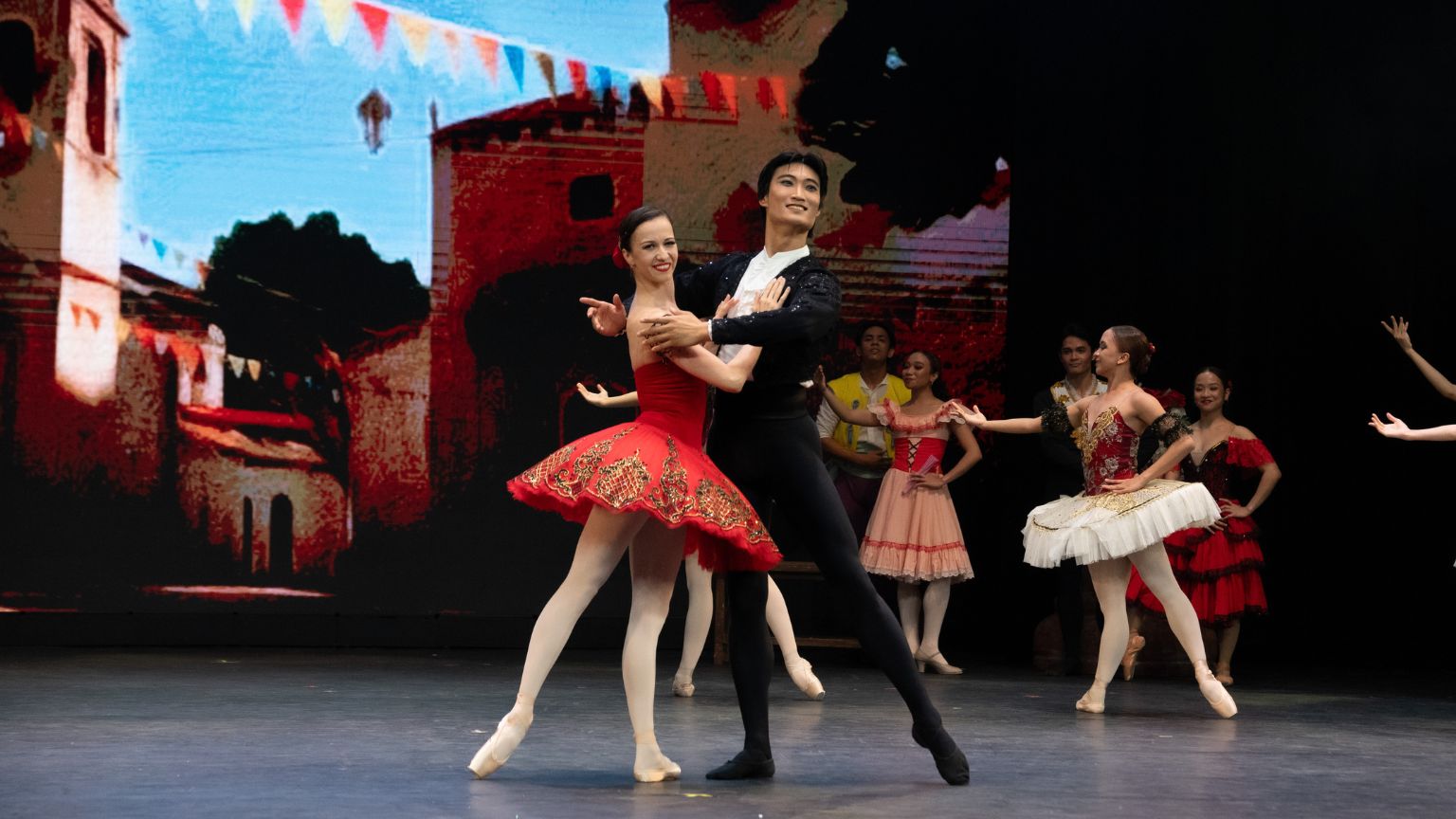
REVIEW: BM’s ‘Don Quixote’ brings star power and ensemble strength to 30th-Anniversary Finale
Ballet Manila (BM) brought its 30th anniversary season to a triumphant close with its signature, Don Quixote, highlighted by the presence of dynamic guest artists from the Mariinsky. The spotlight fell on Kimin Kim—arguably the company’s hottest ticket despite his Korean roots—and prima ballerina Renata Shakirova. Together, they delivered a blend of technical brilliance, crystalline clarity in virtuoso passages, and a deft comic touch that lifted the production without eclipsing Ballet Manila’s dancers. Their style harmonized naturally with the company’s ethos. That kinship traces back to artistic director Lisa Macuja Elizalde, who, four decades ago, became the first foreigner invited to perform with the Mariinsky.
The company’s roster, from the ranks to the principals, complemented them seamlessly. Sean Pelegrin fulfilled each assignment in his supporting parts with surefootedness, while Abigail Oliveiro and Mark Sumaylo delivered a well-matched partnership and a sizzling appeal as the street dancer and toreador. The performance carried the mark of a seasoned company, with soloists reliably strong and every artist committing themselves fully to their roles. What came through most was the fruit of years spent working side by side—trust, camaraderie, and high morale that translated into dancing with a shared pulse and spirit.
Although the ballet bears his name, Don Quixote himself is not the focus of the story. Martin Lawrence, cast in the title role, carried it with dignity, anchoring the humor of the production. The center lies with Kitri and Basilio, the young couple whose romance fuels the action. Around them swirl comic characters such as Gamache, the foppish nobleman who also vies for Kitri’s hand, and her blustery innkeeper father who tries to force the match. Don Quixote and his loyal squire Sancho Panza wander in and out of the ballet, chasing windmills and mistaking Kitri for the lady of his dreams, Dulcinea. In Miguel Cervantes’ novel these episodes occupy only a few pages. French choreographer Marius Petipa extracted this subplot and amplified it into a full-length ballet. Later Russian choreographer Alexander Gorsky made revisions most often performed today—rich with comedy and bravura dancing.
Artistry and Athleticism
Having guested in Giselle last year, audiences had already seen Renata Shakirova’s dramatic range from naïve peasant girl gaslighted by her lover to the ethereal, forgiving spirit of Act II. As Kitri, she revealed yet another spectrum of color. She began by dancing with vivacity, peppering her phrasing with crisp accents of the arms and razor-sharp kicks. This grew into sprightly footwork and buoyant turns, before giving way to pure athleticism in her soaring jumps and mercurial footwork. She contrasted that brilliance with a subdued, otherworldly Dulcinea in the dream sequence. With Basilio, she shifted moods easily—flirtatious in their encounters, piqued with jealousy when he bantered with her friends, openly disgusted with the effeminate Gamache, playfully hammy during Basilio’s feigned suicide, then charismatic as the radiant bride in the wedding pas de deux.
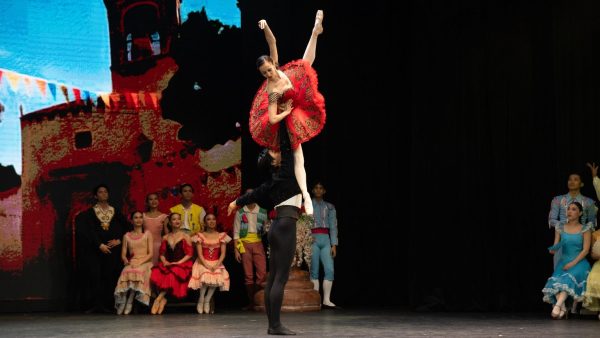
Kimin Kim as Basilio and Renata Shakirova as Kitri; Photo Credit: Erica Feliz Marquez-Jacinto
Her dramatic shading was matched by flashes of technical brilliance. Against the twirling capes of the matadors, she flew through the famous diagonal sequence of turns—racing across the stage with dizzying speed. Elsewhere she seemed suspended midair in buoyant leaps, her back leg soaring above her head in Kitri’s signature jump. In the climactic wedding pas de deux, she launched into the fouettés or whiplash turns with fearless attack—turning with crisp precision, occasionally doubling or even tripling, and never once losing tempo.
The audience couldn’t get enough of Kimin Kim, a natural comedian whose artistry was as memorable as his technique. From the start, he danced with the joy of a boy let loose, yet always in full control. His Basilio carried clear signatures: successive aerial turns that bounced off the floor like a rubber ball, and dramatic renversés—sudden tilts of the torso and head, underscored by a circling leg movement, rooted in Spanish style. These rotations unfolded into sweeping arcs, like waves unfurling, giving each phrase breadth and amplitude.
His solos were a study in elevation and clarity. He suspended himself midair in scissor jumps, legs opening and closing like blades before returning to earth with precision. His double saut de basque—a leaping turn that slices through the air and lands in a smooth rotation—covered the stage like a compass drawing wide circles. His barrel turns, too, stood out for their height and freedom. Humor came naturally, whether with a cheeky kiss thrown to the audience before his mock “suicide” or in his quick-witted reactions to Kitri.
Against this bravura, the subtleties carried equal weight: the intense eye contact with Kitri, the discreet but flirtatious kiss on her nape, and the masculine way he played the castanets. With Renata, the chemistry was instinctive. They didn’t just dance together—they read each other. Lifts were effortless, as if she were made of silk. She would launch herself toward him with trust, and he’d catch her midair as if it were second nature. Even the one-arm overhead lifts—held longer than most dare attempt—looked like a private joke between them, not a test of strength.
In the European tradition, their supported pirouette was a model of understated virtuosity. Renata turned with full command, often needing only the lightest touch of Kimin’s hands on her waist for balance. She turned not because she was helped but because she was free. That quiet confidence, the ability to sustain centered, multiple whirls without visible aid, revealed their shared confidence.
Solos and Supports
BM’s cast commanded the lively street and tavern scenes. Abigail Oliveiro, as Esmeralda the street entertainer, mesmerized the audience with her seductive allure and signature backbends. In the plaza scene, she tackled the Bottle Dance with daring precision. As the matadors laid the bottles, she weaved through them with crisp steps, turning a risky feat into a playful display of control. In the tavern scene, she leapt onto the table, arms flaring like flames,
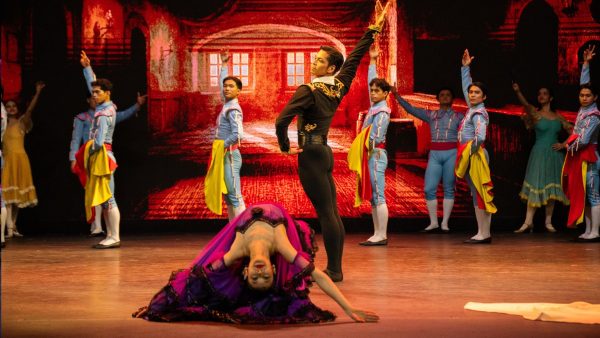
Abigail Oliveiro as Esmeralda and Mark Sumaylo as Espada; Photo Credit: Erica Feliz Marquez-Jacinto
Mark Sumaylo, as Espada the bullfighter, dialed up the Spanish aire, swaggering to the hilt. He embodied machismo with a proud, commanding presence—his strong jumps, dramatic shoulder rolls, and stylized poses channeling the bravado of the bullring. Around him, the matadors moved in unison, swirling their capes with testosterone-driven panache, injecting the ballet with the spectacle of mimicking a bullfight.
The men of Ballet Manila likewise seized their moment in the gypsy scene, delivering it with raw power and fiery energy. Their sharp footwork, soaring jumps, and camaraderie showcased the ensemble’s strength, giving the ballet another surge of masculine vitality. As the lead gypsies, Rissa Camaclang and Romeo Peralta commanded with fierce intensity, setting the tone for a group performance brimming with force. It was one of the evening’s showstoppers.
The supporting cast was perfectly chosen, full of individuality and nuance. Rodney Catubay demonstrated his versatility, moving from the sinister Rothbart in Swan Lake to a playful buffoon in Don Quixote, delivering every comedic beat with timing and flair. Anselmo Dictado balanced comedy and finesse to Sancho Panza, his gestures and expressions punctuating the antics of Don Quixote and the ensemble. John Balagot embodied Lorenzo, Kitri’s father, projecting authority and wry humor that held its own alongside Renata Shakirova’s star power. Together with the quietly powerful Martin Lawrence, the supporting cast infused the street and tavern scenes with life, making the comedy feel vivid.
Harmony
By contrast, the sequence of the Dryads (forest spirits) offered a serene and lyrical escape. In Don Quixote’s dream, Kitri transforms into Don Quixote’s ideal woman, Dulcinea. Renata softened her style into something light and restrained, her delicate arms and fluid lines a gentle counterpoint to the fiery energy of Act I. Abigail, as the Queen of the Dryads, pulled off one of the ballet’s most demanding variations. She held long balances, sustained elegant adagio passages, and capped it with the notoriously difficult Italian fouettés—whipping and unfolding her leg into high extensions while turning—showing both strength and majesty. Adding playfulness, Shaira Comeros was flawless as Amour. She flitted across the stage with airy leaps and precise footwork. Every tilt of the head, flick of the arm and impish smile teased the Dryads and Dulcinea, punctuating the stately tableau with bursts of her charm.
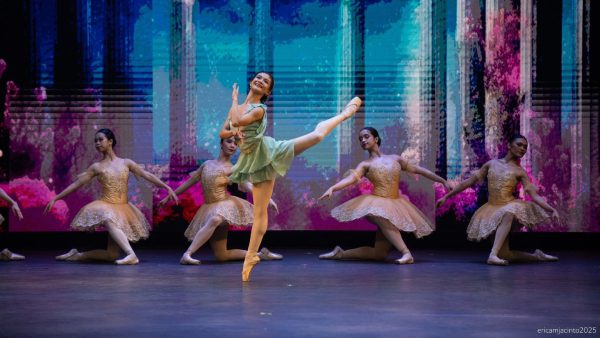
Shaira Comeros as Amour; Photo Credit: Erica Feliz Marquez-Jacinto
The corps de ballet, as the Dryads, flowed in perfect unison and their lines elongated with grace, each dancer echoing the other to create the effect of a harmonious, enchanted forest.
Lisa Macuja Elizalde wove her choreographic touches into smooth transitions. In her take on the Fandango, conventionally a corps de ballet character dance in the style of Baile Español, she created a pas de quatre that highlighted both artistry and technique. It began with shoulder shimmies, a hallmark of the traditional fandango, gradually building into displays of technical brilliance and partnering that moved from grounded steps to soaring jumps and lifts, adding depth and visual excitement. Rafael Perez and Benedict Sabularse leapt and spun with buoyant energy, cutting through the stage like sparks. The twins, Jessica Pearl and Jasmine Pia Dames, displayed their formidable technique and elegant lines. In a striking climax, the men executed kneeling lifts that propelled their partners into six-o’clock arabesques suspended midair, landing with precise poise.
In the Kitri wedding Grand Pas de Deux, her two friends added sparkle and contrast. Shamira Drapete, in the first variation, showcased her strength and beautiful proportions, delivering quick footwork that mirrored Kitri’s vivacity, though her polish could develop further with time. Stephanie Santiago, in the second variation, highlighted grace and fluidity, her trademark jumps and expressive port de bras adding mature contrast to the lively first solo.
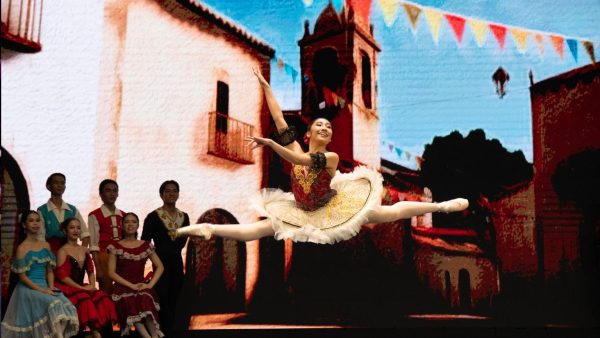
Stephanie Santiago as Kitri’s friend; Photo Credit: Erica Feliz Marquez-Jacinto
The lasting image was not just the virtuosity but the entire cast snapping their fingers in unison—a burst of pitos (the rhythmic finger snaps of Spanish dance) that filled the stage with rhythm and shared joy.
Tickets: P2,060 (Center) and P1,030 (Sides)
Show Dates: August 22 at 8 PM., and August 23 and 24 at 5 PM
Venue: Aliw Theater
Running Time: 2.5 hours (with two 15-minute intermissions)
Creatives: Lisa Macuja Elizalde (overall direction), Eileen Lopez (ballet mistress), Gerardo Francisco Jr. (ballet master), Winter David (set designer), House of Michael Miguel (costume designer), Carlo Reyes (lighting designer), Joyce Garcia (visual projection designer)
Featured Cast: Renata Shakirova (Kitri), Kimin Kim (Basilio), John Balagot (Lorenzo), Martin Lawrance (Don Quixote), Anselmo Dictado (Sancho Panza), Rodney Catubay (Ganache), Stephanie Santiago and Shamira Drapete (Kitri’s friends), Abigail Oliveiro (Mercedes/ Queen of the Dryads), Mark Sumaylo (Espada), Shaira Comeros (Amour), Rissa Camaclang (lead female gypsy), Romeo Peralta (lead male gypsy), Ana Katharina Andes (Dulcinea), Jasmine Pia Dames and Rafael Perez, Jessica Pearl Dames and Benedict Sabularse (Fandango)


Comments